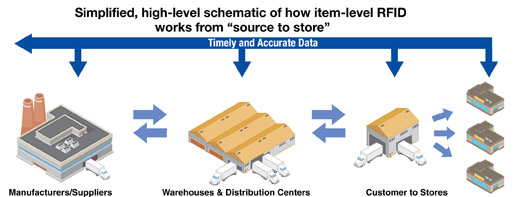RFID surges ahead
Proponents have changed the conversation and have started tagging at the item level in what the industry is now calling a “source-to-store” approach.

The RFID chatter is getting louder. After conducting successful pilots of item-level RFID initiatives, Walmart, then American Apparel, and now Macy’s, Bloomingdales, Dillards and JCPenney have all announced plans to roll out EPC (electronic product code)-enabled, RFID technology at the item level in their stores this year.
For the RFID industry, this turn of events has been electrifying. Not only are these retailers driving RFID adoption, but they’re also propagating the benefits throughout each of their supply chains. This, in turn, creates opportunities for significant process and usage standardization across the industry with the mass adoption of the technology.
Many have already jumped on the bandwagon. An October 2011 study of 58 suppliers and 56 retailers across North America, conducted by Accenture on behalf of the Voluntary Interindustry Commerce Solutions Association (VICS) and its Item-Level RFID Initiative (ILRI), reports that the technology is at a “tipping point” with more than 50% of retailers and suppliers already piloting or implementing item-level RFID.

Joe Andraski, president and CEO of VICS, has no doubt. “The technology has been around for a while, but it hasn’t been used extensively because we haven’t done a lot of extensive tagging—until now,” says Andraski.
Michael Liard, RFID director for VDC Research, has been keeping a close eye on the technology for 12 years and sees the technology rapidly evolving and maturing. “We’re seeing significant developments in terms of innovation, price points coming down, standards being ratified and passed, and use cases being solidified.”
Many credit the groundwork laid by Walmart and the Department of Defense in 2004 where the focus was the EPC tagging of cases and pallets. True, it might not have reached the levels of success they expected, but it became the foundation that proponents have used to change the conversation and start tagging at the item level in what the industry overall is calling a “source-to-store” approach.
More item-level tagging
With multiple pilots completed and full roll-outs on tap, the expected benefits of item-level tagging have been well-documented. Inventory accuracy has improved to rates above 95%; the time required for workers to perform cycle counts in stores has decreased by up to 96%; and out-of-stock events have decreased by 50%.
According to Andraski, it’s the reduction in out-of-stock events that has been the biggest differentiator. “When a shopper goes to retailer X and the product’s not there, it’s a lost sale and it’s also a dissatisfied consumer.” In an RFID-enabled supply chain, shoppers would rather go to Macy’s or Bloomingdales where they know their favorite products are in stock.
This means more sales, which subsequently means more revenue to all trading partners within that chain. Andraski reports that research has shown increases in sales for stores with EPC tagging between 4% and 21% and averaging about 6%. “That’s huge,” he adds, “especially in this economy.”
What does the adoption of item-level RFID tagging mean to the many warehouses and DCs that support these retailers and their suppliers? It means streamlining DC operations to fully leverage RFID’s value. It’s leveraging RFID’s ability to capture information on multiple items simultaneously and remotely, without line of sight. It’s checking an order without opening a carton. It’s automatically identifying and counting groups of pallets, cases and items in one read where bar codes were previously used to manually scan them one at a time.
Though most of the tagging is limited to the supply chains of replenished apparel such as jeans, underwear and socks, plans are underway to add more product categories. It’s especially straightforward in a closed-loop supply chain when the apparel manufacturer owns its supply chain from end to end.
“American Apparel is a perfect example,” says VDC’s Liard. “They manufacture their clothes; they distribute their clothes; they sell them in their own stores. That organization can use RFID at the point of manufacture, they can use it in the warehouses and DCs, and they use it in the retail store.”
Other item-level tagging initiatives have started as a result of anti-counterfeiting and brand protection programs for other types of products. “They’re using RFID at the item level in pharmaceuticals,” notes Liard. “As it gets manufactured and goes through the supply chain, there’s a chain of custody called its ‘e-pedigree.’”
Click here to download PDF article
Much improved readers and tags
While spotty read performance and stray tags may have prevented many from adopting the technology, significant hardware and software developments is changing minds. Readers have been able to capture tag information from longer distances consistently. For example, Motorola has introduced a more ruggedized next generation RFID reader that has handled increases in volume of items moving through warehouses and the reading of tags in densely packed pallets.
“Based on customer feedback, this RFID reader offers a greater level of sensitivity—being able to read tags in more challenging environments and on more products—and provide more configuration options that can be tuned within harsh industrial situations,” says Mike Maris, senior director for Motorola.
In addition, Intermec’s latest network readers, released in early 2011, have longer read ranges and offer the ability to read more tags, faster. According to Kurt Mensch, Intermec’s principal product manager for RFID, its Advanced RFID Extensions (ARX) can determine the motion of tags to identify tags of interest and discriminate surrounding tags.
Each year it’s not uncommon to see smaller, more powerful tags introduced into the market for a growing number of uses. Inlaid in different forms and paper mediums, they can now be easily attached to a wider range of assets—from airplanes to sheets of paper or even loads with liquid and metal—and still be consistently captured by today’s readers.
And, Omni-ID recently launched a tag that combines RFID with e-paper technology. Ed Nabrotzky, Omni-ID’s CTO and marketing vice president, calls it visual RF tagging. “Visual RF tagging allows wireless tracking of items like other active systems, but adds the element of dynamic visual cues for the worker.” The tag combines RFID with a display that can show product locations, pick instructions for an order, or any other human-readable information, allowing the system to instantly communicate to workers new tasks to perform on the fly, such as quality holds or re-routing of orders.
Convergence of technologies
There has also been innovation in how RFID software and hardware are being used not only in isolation, but also as part of other wireless technologies to minimize inaccuracies while maximizing efficiencies within the DC.
For example, the RFID system introduced by TotalTrax automatically captures and tracks the physical movements of a lift truck fleet by “combining different forms of data collection devices—optical, RFID, position based—and load detection sensors, combined with optical positioning and our software,” according to Sarah Brisbin, marketing director for TotalTrax.
This “smart truck” dramatically enhances warehouse management system capabilities based on real-time knowledge of the actual location of each lift truck, optimizing operator movements and task interleaving.
Intermec also offers another reader, which according to Mensch, is the only long-range handheld RFID reader on the market that combines five wireless technologies in one device: RFID, wireless WAN, GPS, Wi-Fi and Bluetooth. “This flexibility allows a single reader to be used for any application, from asset management inside the warehouse to trailer management in the DC yard,” he adds.
To help add to this momentum, tag costs have been declining and are expected to be driven down with widespread adoption by retailers at the item-level. In fact, just a small decrease in cost can have a substantial impact. A retailer, for example, that ships 100 million units per year can save as much as $1 million with just a penny saved per tag.
According to Liard, ROI times have shrunk over the last few years. “There is increasing evidence that it’s been less than a year.”
RFID’s Catch-22
While there are more drivers than ever pushing RFID’s adoption, not all are convinced. Andraski believes a lack of education is holding companies back from investing and innovating. One of the biggest challenges, he says, is that companies view RFID initiatives as a source of competitive differentiation; thus, it’s been a challenge to get users to share their experience and their ROI modeling.
“Others can’t learn if they don’t share their success story in a public fashion,” says Liard. “It’s a Catch-22 for RFID.”
New RFID guidelines for retailers and suppliers unveiled by VICS Board
Suppliers, retailers and solution providers seeking help on efficient identification, serialization and placement of Electronic Product Code (EPC)-enabled RFID tags should benefit from new guidelines that were announced today by the Board of Directors of the Voluntary Interindustry Commerce Solutions Association (VICS).
Click here to download PDF article

Article Topics
Latest in Materials Handling
Hyster recognizes Dealers of Distinction for 2023 Carolina Handling names Joe Perkins as COO C-suite Interview with Keith Moore, CEO, AutoScheduler.AI: MODEX was a meeting place for innovation Walmart deploying autonomous lift trucks at four of its high-tech DCs Coles shops big for automation Kathleen Phelps to join FORTNA as chief financial officer Coles automates grocery distribution in Australia More Materials HandlingAbout the Author
Subscribe to Materials Handling Magazine

Find out what the world's most innovative companies are doing to improve productivity in their plants and distribution centers.
Start your FREE subscription today.
April 2024 Modern Materials Handling

Latest Resources










